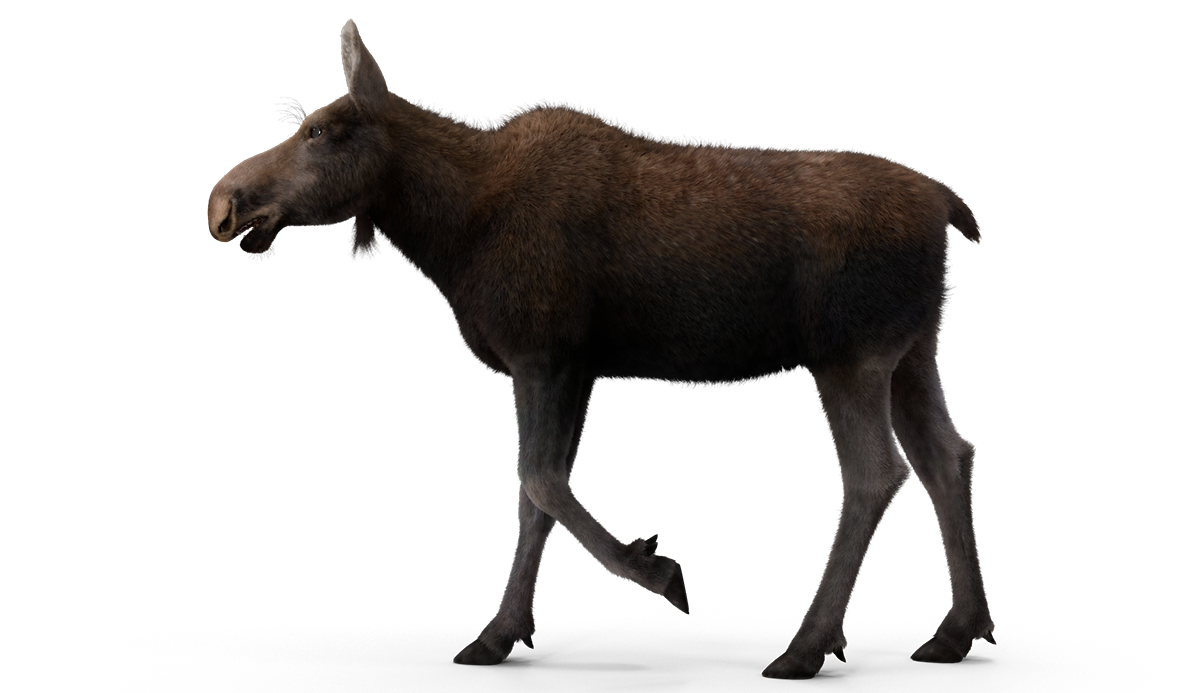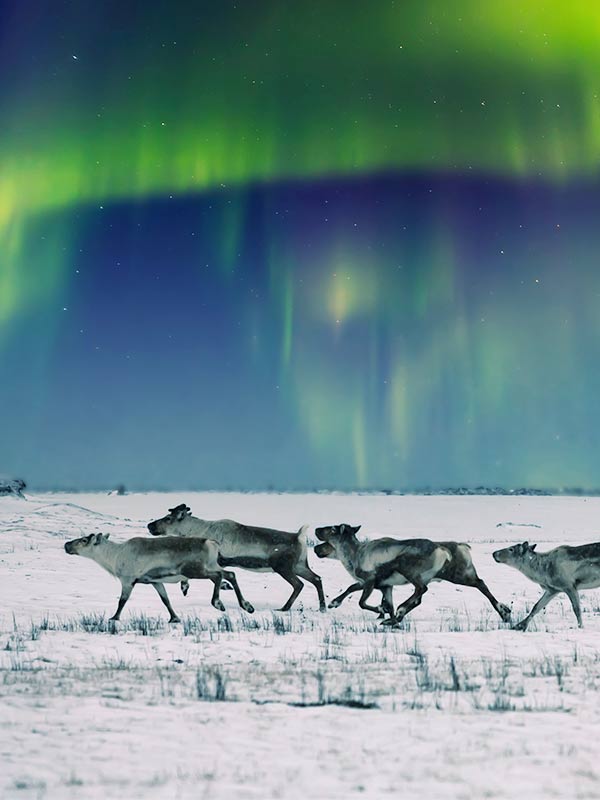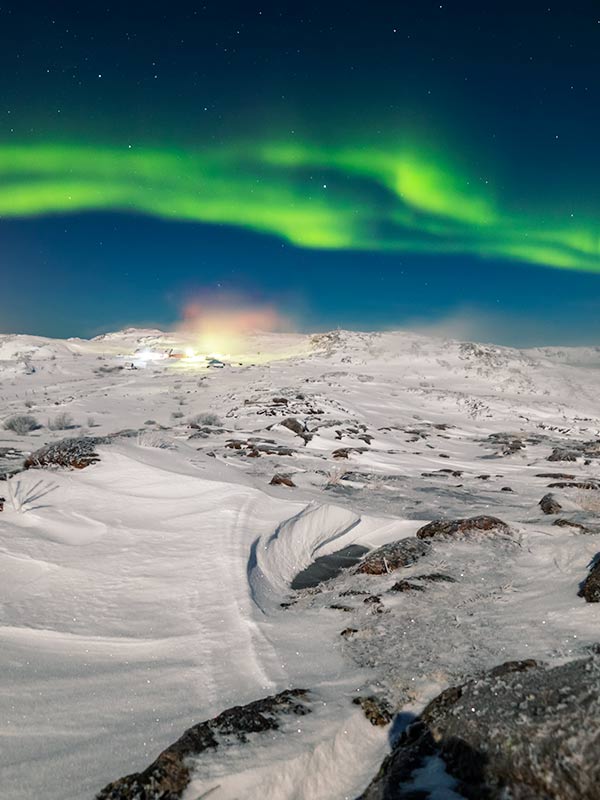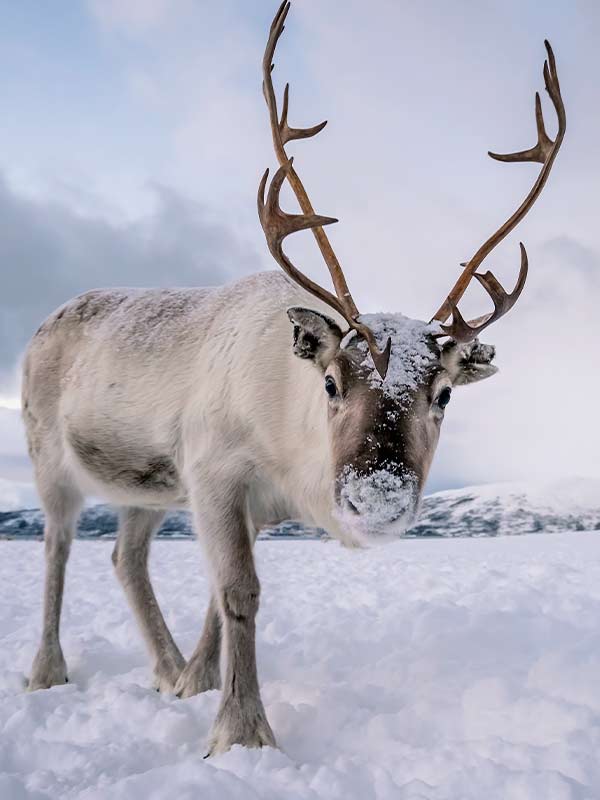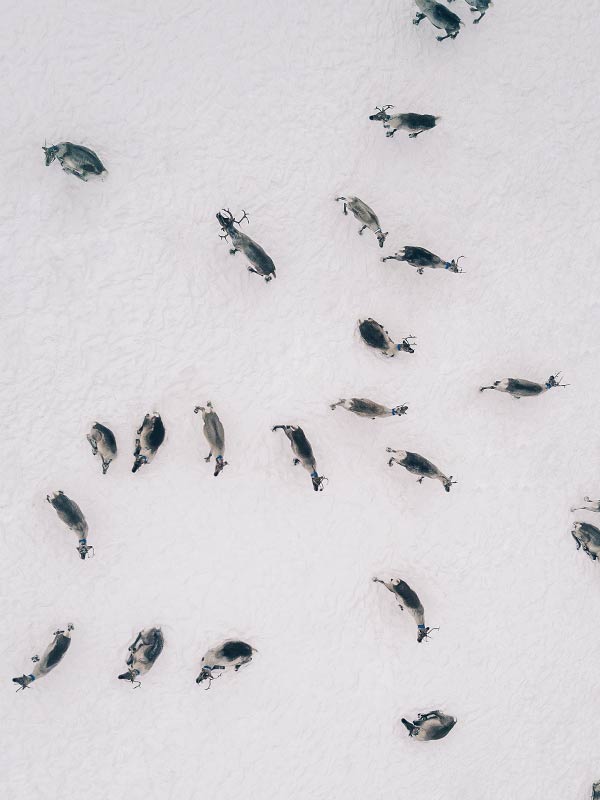Select Page
The arctic Tundra
The word tundra is believed to come from the Finnish word “tunturia”which refers to a treeless plain. This feature helps define the tundra. In transition zones from other biomes, such as the taiga or coniferous forests, stunted trees and shrubs are all that grows. Another factor that helps define the vegetation in the tundra, and thus the tundra itself is the presence of permafrost, a layer of permanently frozen ground just below the surface
The arctic tundra is changing
The tundra is controlled by the extremes, with very cold winters.
The Tundra is defined mainly by permafrost, lack of trees, low biodiversity, and harsh conditions. It occupies the area between the polar ice caps and the boreal forests (or taiga). This truly fascinating region can seem lifeless at first, yet, despite its challenges, it hosts a diverse and unique range of organisms.
Note: Similarly, Alpine tundras are defined by harsh weather and lack of trees, however, they do not have permafrost and the thing that most restricts tree growth is the altitude where they are found. We treat alpine tundra biomes in their own section, here.
What defines the arctic tundra biome? What is the climate of the arctic tundra biome? What lives in the arctic tundra? What adaptations do arctic tundra plants and animals have that allow them to survive here? What adaptations do arctic tundra migratory animals have to allow them to travel such great distances so often? That’s what you’ll learn by spending a few minutes browsing this article and associated media..
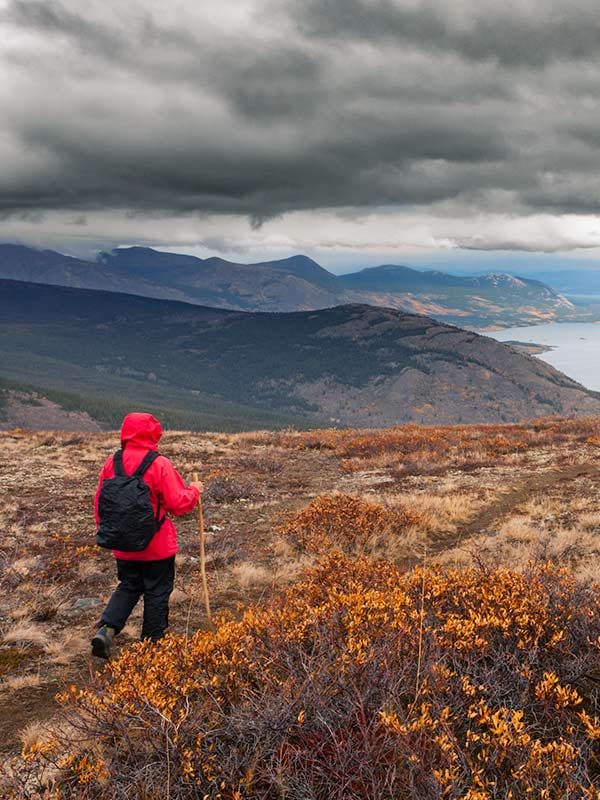
WHERE IS THE ARCTIC TUNDRA FOUND?
The arctic tundra is found almost entirely in the Northern Hemisphere, from 60 to 70 degrees latitude North. There are also similar habitats in the southern hemisphere, found on isolated islands off the coast of Antarctica and the Antarctic Peninsula, but note that not everyone considers this true “Arctic Tundra” because it is in the south.
This biome forms a belt around the arctic ocean, a transition zone from taiga to the polar ice caps, covering about 20% of The Earth’s surface, in Alaska, the Northern Coast and islands of Canada, Coastal Greenland, Iceland, Northern Europe (Scandinavia), Svalbard (an island north of Norway), and most of the Northern Coast of Russia and Siberia.
Temperature in the tundra
The arctic tundra, though very cold for much of the year, is said to be more strongly defined by its cool summer temperatures, instead of its winter lows. Why? Because these low summer temperatures limit the growth of plants in the summer, where in some biomes like the taiga, longer warmer summer temperatures allow for a better growing season.
In summer, the temperature ranges from 3°C (37 °F) to 16 °C (60 °F), with peaks occurring in July and August. In winter, which lasts from 6-10 months depending how far north you are, the average temperature of the tundra is around -28°C (-18.4 °F) while extremes can dip to -70°C (-94 °F)!
Sunlight hours of the tundra
Overall, there is a lack of sunlight in the arctic tundra. In the peak of summer, there are 24 hours of sunlight, but the sun remains fairly low on the horizon. This phenomenon is what gives this biome its nickname – the land of the midnight sun. In the peak of winter, the opposite occurs, and the entire landscape experiences complete darkness. The further north you go, the longer the sunless period.
The combination of low temperatures and sunlight hours results in a growing season that is only about 6-10 weeks long. This is a huge factor for what is able to survive here.
Watch a timelapse of “The Midnight Sun”
Precipitation in the tundra
Precipitation levels in the tundra range from 15-25cm (6-10 inches) a year where most falls as snow. This could technically define the arctic tundra as a cold desert, especially because there are also harsh dry winds that whisk away air moisture. However, there is still quite a bit of moisture on the ground and in the soil due to (1) the lack of evaporation from low temperatures and (2) the permafrost.
Each summer, the melting snow and the top layer of this permafrost forms many small bogs and ponds scattered across the landscape. The water does not soak into the ground because the permafrost blocks it. In the winter these pools freeze and the cycle repeats itself. This patchy water also results in interesting clusters of vegetation, which we will discuss more below in adaptations of arctic tundra plants.
Soils of the tundra
The arctic tundra does not have proper soil layers, like those that can be found in a temperate grassland for example, but instead has a very small active layer, which is the part of the soil that contains life and allows plant growth, and permafrost.This soil experiences a lot of freezing and thawing and is classed as a Gelisol Soil.
The active layer of the soil is the part that melts in the summer and allows life, and can be from 25-100cm (10-40 inches) deep. Life here is very interesting because it continually experiences freezing and thawing between the seasons. Similar to the other trends we have seen, the further north you go, the smaller active layer you have and the more limited growth is.
This small active layer is also relatively low in nutrients and is usually water-logged, meaning that the water does not drain and there is very little dry space in the soil. The cold weather and high water content creates poor conditions for decomposition, and most of the available nutrients come from animal waste. These factors further increase difficulty for life in the soil, including plants and different organisms like worms or microorganisms.
The most distinct part of the arctic tundra soil, and perhaps the whole biome, is that of permafrost. Permafrost refers to the soil that is frozen solid all year round, and does not even melt in the summer. The permafrost starts anywhere from 25-100 cm down (remember where the active layer ends?) and can go all the way down to 450 meters (~1475 ft) below the surface.
This permafrost does a few key things: (1) it prevents the growth of large trees, because they can not put their roots deep into the ground; (2) The melting of its top layer provides much of the water in the ecosystem and creates the ponds and wetlands throughout the landscape; (3) it prevents the draining of water, which causes the water-logged soils mentioned above; (4) it stores large amounts of carbon, methane and other gases.
BIODIVERSITY IN THE ARCTIC TUNDRA
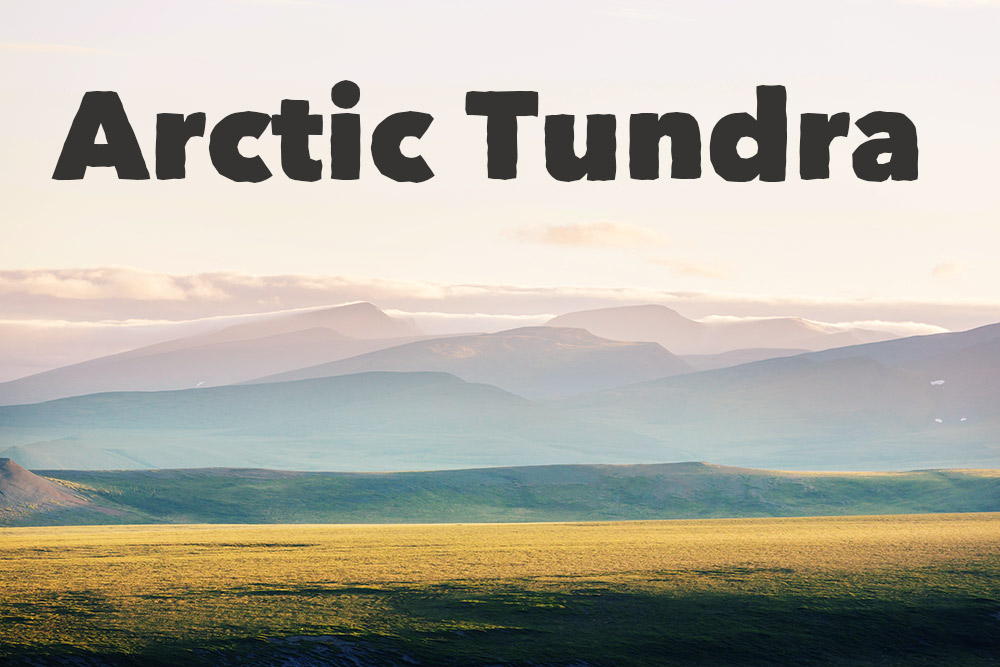
What lives in the arctic tundra biome?
On a relative scale, the arctic tundra biome has low biodiversity, especially if you compare it to somewhere like the tropical rainforest. Conditions here make it difficult to survive, and require specific adaptations to thrive here. Despite this, there are around 1700-2000 species of plants that manage to live in this zone. In terms of animal life, much of the diversity is made up of migrant animals, those that come here in the spring and leave before winter, such as massive herds of caribou or large flocks of various bird species. Resident animals, animals that live here year-round, consist of about 48 land mammals, some birds, a few hardy insects, and no reptiles or amphibians.
Plant adaptations to the The Arctic Tundra
Between the harsh climate, short growing seasons (50-60 days), and poor soil conditions, the arctic tundra is a difficult biome for plants to grow. Plants include things like: low-lying grasess, like tundra grass (Dupontia fischeri), mosses, such as Sphagnum mosses, lichen, largely reindeer lichen (Cladonia rangiferina), low-lying shrubs, mountain cranberry (Vaccinium vitis-idaea) for example, cushion plants like the three toothed saxifrage (Saxifraga tricuspidata), some 400 flowering vascular plants, like the Dwarf Fireweed (Chamerion latifolium), and even bush-like willows (Family Salicaceae) that only grow around 8cm (3 inches) off the ground.
Microclimates of varying degrees of air moisture, wind, soil moisture, soil quality/soil type and available nutrients control the plant communities and make for the interesting patterns seen in the tundra. In the windiest areas you can find matted cushion plants and some grasses, on rocky areas mainly lichens, mosses and fungi, and the vascular plants, dwarf-shrubs, and peat mosses dominate the “less harsh” areas, where the snow melts sooner, the wind is not so persistent, and there is lots of groundwater.
The absence of trees in the arctic tundra is partially due to the growing season, where trees need at least 1 month of steady temperatures above 10°C (50 °F), but is mainly due to the permafrost limiting root growth.
In saying this, plants in the tundra must have shallow roots that stretch outwards instead of down into the soil. They must also be able to withstand the freeze-thaw dynamics and survive with little soil nutrients. As well, the patchy water logged versus rocky-dry areas make it so plants either need to be able to survive in lots of water, or with little water. This creates small communities of distinct plants dotted throughout the landscape.
Lichens and mosses for example are able to grow on rock and absorb water out of the air. This does mean though that they need quite a bit of moisture, so when it is dry they will go temporarily dormant, and revive when there is more moisture again. On the other hand, plants like carnivorous bladderworts (Utricularia), can be completely emerged in, or float on top of, the water and will dominate flooded areas.
Plants have many ways to deal with the short growing season. Most plants of the tundra can grow very quickly in a short amount of time. Many flowering plants bud the moment the snow has melted. Plants are also mainly perennials, meaning they go dormant for winter and come back to life with spring. As opposed to annuals which grow in the summer and die in the winter.
These plants are also adapted to photosynthesize with very little light, and in low temperatures, something that is difficult for plants further south. There are even some plants that are able to store energy in their roots during the growing season to maintain them, or even to grow, underneath the snow in winter. Towards the end of the season, and for some plants all year, you will also notice more reddish coloring, this helps these plants to absorb a wider spectrum of light and take advantage of the little sunlight coming over the horizon. Interestingly, dry air and driving winds also makes for plants that have similar adaptations to those in the desert, such as thick waxy leaves that prevent water loss.
In addition to these issues, plants need to stay warm. One strategy for this is that many plants will grow tightly packed together, as well as very close to the ground, to stay warmer and avoid cold air and harsh winds. Many plants, such as cotton grass (Eriophorum), also have hairy stalks which helps to insult them. Last, flowering plants tend to have large, and often dark, flowers that absorb more heat. The arctic poppy (Papaver radicatum) is even able to orient its flower towards the sun to always receive maximum light.
For reproduction, many plants rely on methods other than flowers, as there are fewer pollinators here when compared to the rest of the world. There is a variety of different strategies for reproduction: Mosses for example use spores, primroses (Primula) use buds, where new individuals grow out from parts of the parents plant, or plants can use runners, where new shoots will sprout up from the roots of the parent plant, like those in the heath family (Ericaceae).
Animal adaptations to the The Arctic Tundra
The extreme conditions of the arctic tundra biome lead to large fluxes in animal populations, seasonally and even through the years. A large majority of life found here is that of migrants, the animals that only live here in summer, but there is an impressive group of resident animals as well.
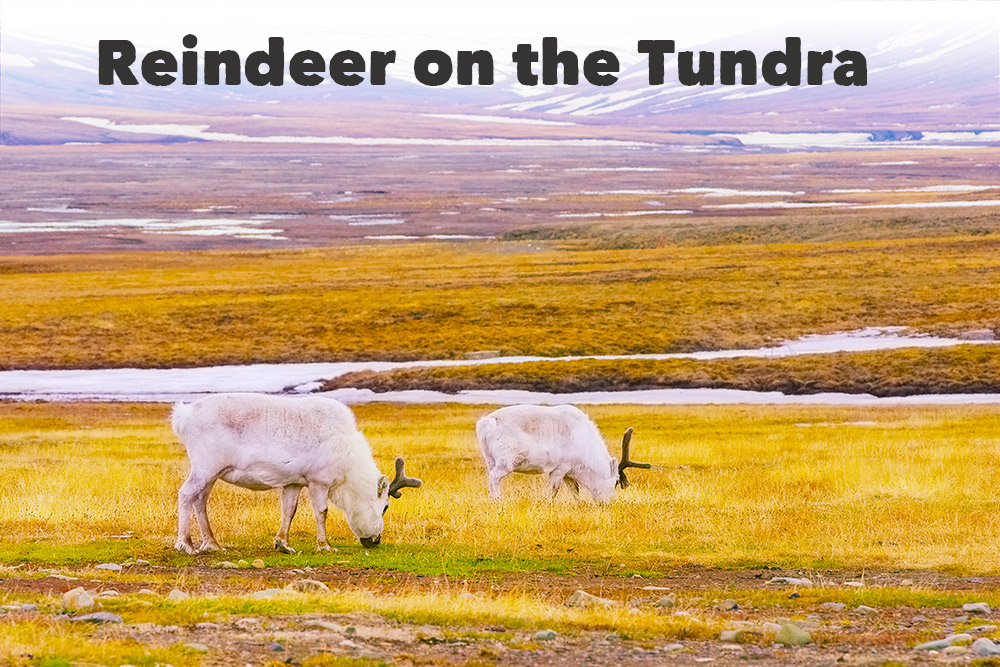
Residents
The animals that spend the entire year in the arctic tundra biome have a variety of adaptations to help them deal with the extreme conditions here.
In the case of mammals and birds, such as polar bears (Ursus maritimus), arctic foxes (Vulpes lagopus), muskoxen (Ovibos moschatus) and more, some of the strategies are the same. They have very round builds, which means less surface area to lose heat, short ears and tails, very thick insulating fur/feathers, feet that are wide (also with thick fur/feathers) that help them walk on the snow, and the ability to create fat stores in summer to help them last through, and stay warm during, the winter.
Another interesting characteristic of a few tundra animals is the changing of their fur coats between summer and winter. Arctic hares (Lepus arcticus), arctic foxes, and even rock ptarmigans (Lagopus muta) not only put on thicker fur for the winter, they also change the color from dark browns to white, and vice versa, to better help them camouflage, no matter the season.
Some animals, such as the arctic ground squirrel (Spermophilus parryii), hibernate through most of the winter in order to avoid it all together. Hibernation is the act of lowering body temperature and metabolism to stay asleep for long periods of time. The arctic ground squirrel in particular can hibernate for 7-8 months of the year. Surprisingly, arctic ground squirrels can actually super cool their body temperature to below 0 in order to stay asleep for longer periods and burn very little energy.
Interesting note: Listen to this podcast from The Wild on how these squirrels are being studied in order to look at helping humans “hibernate” during space travel.
Other rodents, such as voles (family Cricetidae) and lemmings (tribe Lemmini) stay awake during the winter. These animals are much more active and mainly reproduce in the summer, while in winter they make intricate burrows beneath the snow, where it is warmer, and live among the roots of the largely dormant vegetation. A curious fact about lemmings is that they have large cycles in their populations, over 3-4 years, where they experience large spikes and drops in the population. Since they are an important prey species of many tundra predators, foxes and birds of prey like the snowy owl (Bubo scandiaca) for example, the predators also experience these interesting cycles.
The resident animals have to make do with the little available food. Rock ptarmigans feed on buds and other exposed plant material, rodents on roots and other plant parts under the snow, while muskoxen and caribou (Rangifer tarandus) use sharp powerful hooves to dig into snow and ice and feed on the buried grasses, shrubs and lichen.
Example of the Muskox
The muskox is an incredible tundra animal that has actually been around since the time of the mammoth and has not changed! They have all the adaptations necessary to live here, short stout bodies, thick fur, sharp hooves for digging and key behavioral strategies, such as huddling for warmth or forming tight circles around their young to defend themselves from predators such as the arctic wolf (Canis lupus). They even have helical nasal cavities, which causes the air they breathe to warm up before it enters their body! Interested in Muskoxen and their conservation, click here or watch this video.
Though it seems impossible, there are a variety of insects that not only live but thrive in the tundra such as: mosquitoes (Aedes nigripes), wolf spiders (family lycosidae), arctic bumblebees (Bombus polaris), black flies (family Simuliidae), deer flies (Chrysops sp.),, biting midges (Family Ceratopogonidae) AKA “no-see-ums,” and more. These populations that burst to life in the short summers are part of what brings many migrating birds here. These insects generally have longer larval stages, some up to years long, and shorter adult stages, where the larvae are able to survive freezing through winter and emerging in spring each year until they are ready to mature and reproduce in the short summer, taking advantage of all the still water. The mosquito of the arctic tundra actually has an antifreeze compound in their bodies that helps them resist freezing. Additionally, unlike similar species to the south, many black flies and mosquitos here do not require a blood meal to lay their eggs. (Read more on the mosquito and its life cycle here).
Last but not least, fish such as: cod, flatfish, salmon, arctic char and trout live in fresh and/or saltwater of the arctic tundra and are a huge part of the ecosystem, especially for bringing in migrant birds in the summer. These fish are able to survive in the very cold, and oxygen-poor, water underneath the ice in the winter.
MIGRANTS
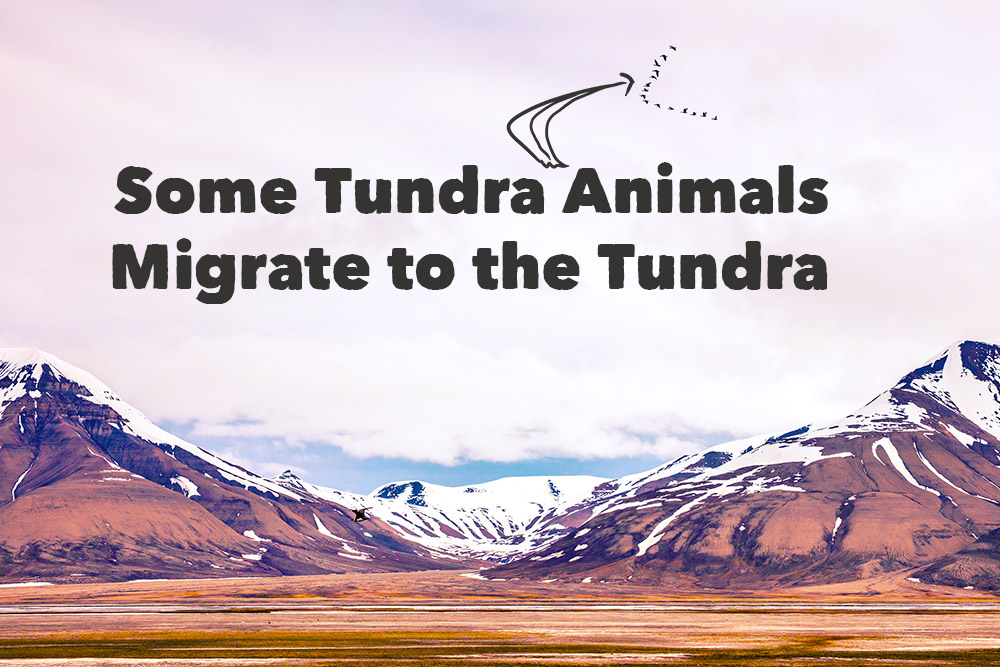
Migrant animals are masters of taking advantage of the productive short summers of regions like the arctic tundra, then heading south before having to endure its difficult winters. Though it takes an extreme effort to migrate such long distances, these animals can get “the best of both worlds” with this strategy by taking advantage of the lack of predators, abundant fast-growing plants, and plentiful insects and fish. However, there are some key adaptations to make this possible.
First, migrant animals need to be able to travel very long distances. Many times, these animals arrive exhausted and almost starving, but they do arrive. Second, since most migrants go north to breed and raise their young, their offspring need to be able to grow extremely quickly to make it back south. Due to this, most birds that are migrants are monogamous, meaning that they mate with the same individual for life, and both parents help to raise and feed the chicks, as their food demand is very high to allow for this rapid growth. Examples of migrating birds are Snow Geese (Chen caerulescens), Barnacle Geese (Branta leucopsis), various shore birds, arctic terns (Sterna paradisaea) and even the peregrine falcon (Falco peregrinus), only to name a few.
Each and every one of these migrations are impressive, for example, 5 million snow geese come to the arctic tundra to breed in spring from the Gulf of Mexico, a 3 month long journey, and the peregrine falcon can come all the way from South America, but the largest yearly migration is undertaken by the arctic tern which spends some of the year in The Arctic and the other in The Antarctic (Listen here to learn more)
Caribou are also famous migrants, with gigantic herds arriving in the hundreds in spring, however there are populations in certain areas that do stay year round.
Note: do not forget that fungi and microbes are also super important parts of the ecosystem, especially for helping to cycle nutrients! We are learning more about them everyday but we do know that the microbial community changes a lot between seasons as well!
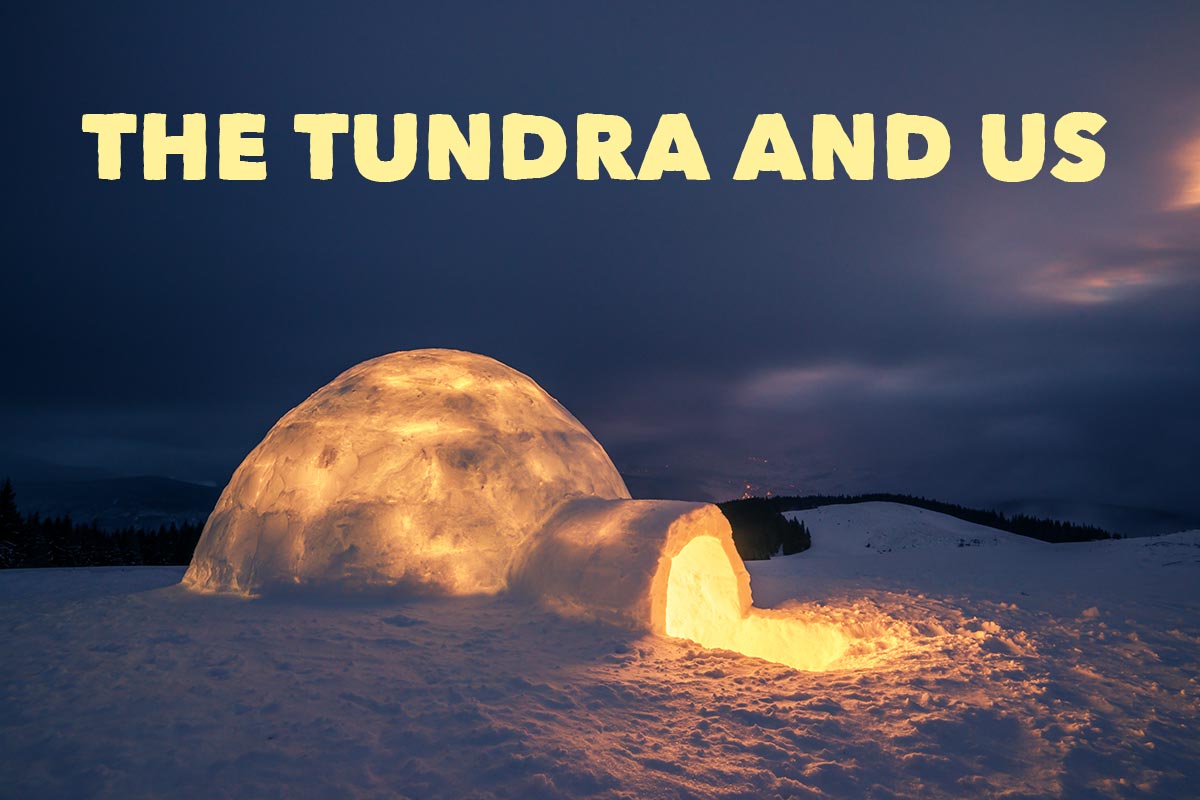
THE ARCTIC TUNDRA AND US
What is life like in the arctic tundra?
Since the arctic tundra has such a harsh climate, there is also a very low number of people that live there, less than 4 million. Despite this, various native tribes have called the tundra their home for a long time. For example, the Inuit peoples in Canada and Greenland (which consists of various distinct tribes), the Yu’pik, in Alaska, as well as Saami in Northern Europe, only to name very few of the distinct groups that call the tundra their home.
See this page for an excellent overview of Arctic Tundra peoples.
The people that have lived here historically relied on, and many still practice, a hunter gatherer lifestyle, following herds of animals or hunting marine mammals and fishing, and gathering eggs of birds and various tundra plants to eat. Though there has been a huge modernization to many peoples way of life, such as more often using snowmobiles than sled dogs, many groups are keeping their traditions alive to this day.
There is also a population of non-traditional peoples that live here. Primarily living via resource extraction and tourism. There are also more and more people moving into the north, especially with better and better technology making it easier to live here, even in the difficult winters.
Besides the people that do live there, the arctic tundra also has some “human migrants” that visit for tourism, from anything to seeing northern lights in the winter or coming to see the incredible migrant bird populations, for resource extraction of fossil fuels and various minerals, and for research.
Direct impacts on the arctic tundra by humans
With our increasing population and activity in this biome comes various threats to the native flora and fauna. Since resources are generally low, dispersed unevenly, and vary in abundance according to the season, the majority of tundra animals need very large habitats that they can move in between easily. The increase of infrastructure, such as buildings, pipelines, roads and more, creates what we call habitat fragmentation. This refers to when habitats are broken up, and it may be difficult for animals to travel between them.
Additionally, pollutants in this already fragile ecosystem can be very harmful. Plants here, especially lichens for example, are extremely sensitive to pollutants and can die off rapidly from both surface and even air pollution. Loss of these plants can be detrimental for animals that depend on them, and can even cause die offs exposing the ground and causing more rapid melting in spring, see the consequences of this in indirect impacts below. Pesticides used to help reduce hoards of insects also reduce the food available for migrating birds that depend on this food source, as well as enter the food chain, causing health problems in predators and their young.
Indirect human impacts on the tundra
Though we do have some direct impacts on the arctic tundra, our indirect effects are probably much more harmful. Climate change is causing a huge change in the arctic tundra, mainly through much warmer temperatures.
Throughout history, the arctic tundra has been considered a carbon sink, meaning that more carbon is trapped here than released. How? Well as plant material grows, it takes in carbon, and because of low decomposition rates and permafrost, when plant material dies here it doesn’t break down and release that carbon back into the atmosphere, instead it becomes buried in layers and stays trapped. However, with warming climates, there are parts of the arctic that are now losing their permafrost, decomposing more rapidly, and even having more frequent wildfires in places that have not burned for a long time. This is causing some areas to convert from a carbon sink to a carbon source, creating what we call a positive feedback loop – where more carbon is released and increases temperatures, which leads to more carbon released, and so on. Some newer research even indicates that melting of permafrost could release toxic gases that have been stored there for a very long time.
Additionally, these increased temperatures are vastly changing the plant communities which impacts the already delicate balance of this harsh ecosystem. A biome such as this that is already under a lot of stress naturally, can not handle too much disturbance. For example, Shrubs and spruce that used to not be able to grow in these gelisols now exist in some areas of the tundra, altering the habitat of the native animals. As well, a notable drop in lichen is one of the reasons caribou numbers are dropping. Interestingly, reduced numbers of large herd animals can also create a positive feedback loop, because these herds pack the snow and ice as they move along it, which also helps to slow snow melt in the summer.
Interesting note: There is new exciting research looking into the possibility of restoring large herds of animals to help slow melting in the arctic tundra. Read more here or see the research paper here.
As well, the changing plant communities and warmer climate means that the range where animals live is shifting. Species that normally live further south are encroaching into the habitat of tundra animals, causing new competition and difficulties for these animals, many of which already have low populations or are considered species at risk. For example, this is being seen with red foxes and arctic foxes or grizzly bears (Ursus arctos horribilis) and polar bears. Polar bears, though largely associated with the polar ice cap biome, often come into the tundra during the summers when sea ice is greatly reduced. The issue is, food here for them is already less plentiful, and less calorie rich, meaning any more competition can be very problematic. Lack of food and higher competition can also lead them to more often search for food in towns, causing human-animal conflict, which can sometimes result in the animal having to be euthanized, if relocation does not work the first time.
You can read this account from a scientist, Anneka Williams, from their time studying in the arctic tundra for an overview of their observed changes and impacts.
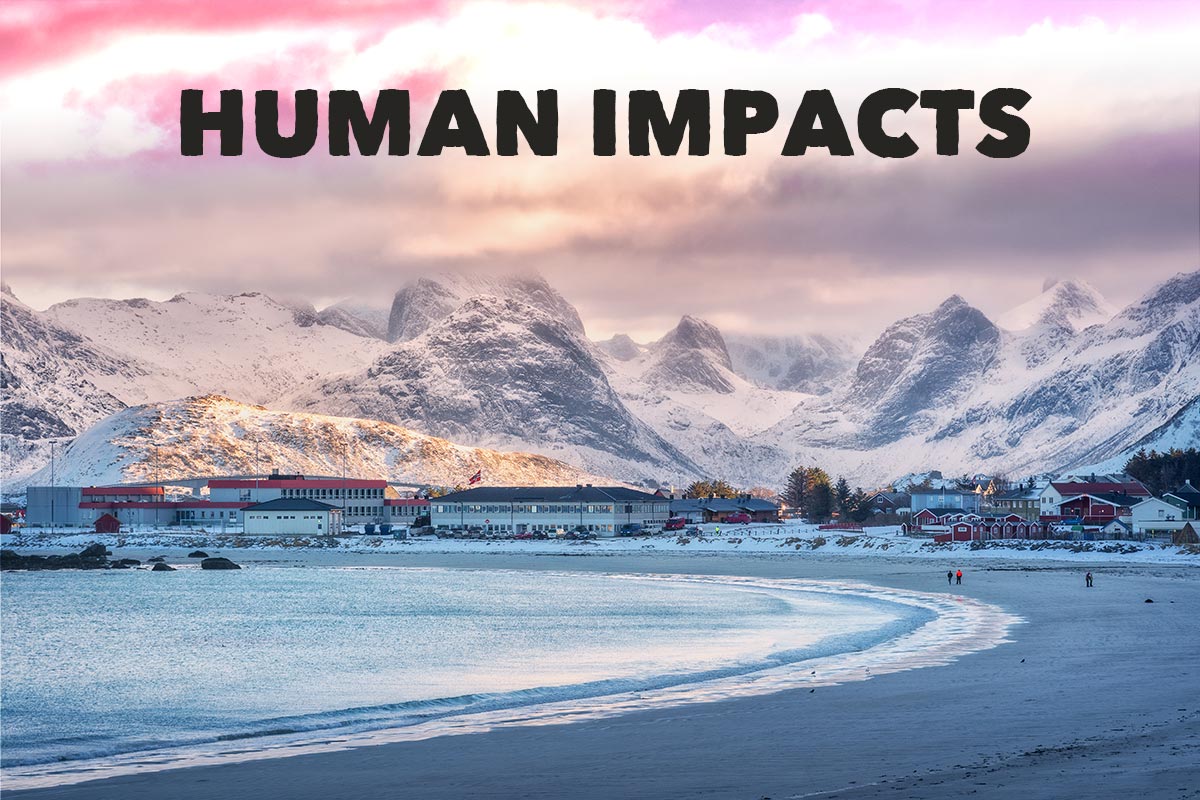
What we are doing to mitigate these issues and what can you do?
There is a fair amount of research being done in the arctic tundra to help understand its dynamics and better slow these changes. We can donate and/or get involved in these initiatives to help scientists figure out the best way for us to help these biomes. See what your local universities and institutions are doing to help the arctic tundra.
Protected areas and national parks are being established to help species at risk. For example, Canada now has 8 separate national parks within the arctic tundra and many other countries have done the same.
Governments, corporations, and individuals are becoming more conscious about their greenhouse gas emissions and are making changes – though we still have a long way to go. This is a big way you can help, through individual choices and by encouraging your government to make greener policy choices.
Infrastructure is being developed to help reduce fragmentation. For example, in Alaska USA parts of a pipeline have been built raised-up to allow passage of caribou herds.
The arctic tundra is truly an incredible ecosystem with unique plants and animals that are very vulnerable to our actions, and whose future depends on us. We must protect this region so that future generations can enjoy its beauty, and so that the people that live here can continue their traditional way of life.
What it’s like to do research in the alpine tundra
Here is a short interview we did with Zoe Walker from the University of Calgary. Her research is focused on understanding the quantity of greenhouse gases (CO2/CH4) that accumulate under the ice of Arctic lakes near Cambridge Bay, Nunavut. Have a listen, it’s really interesting.
Winter Survival Course
As luck would have it, we actually run a 3 day Winter Survival Course that we call Snow Camp in northern Wisconsin every year if you would like to learn how to survive in the Frozen North! It’s not exactly in the tundra – more boreal forest and northern temperate forests, but it’s a great introduction to how to survive very cold conditions.
The Tundra in 360 VR
Explore these clips to view the tundra in virtual reality. If you have a pair of headsets, put them on now.
This article was revised and written primarily by Kirstynn Joseph
Ready to explore more biomes in Virtual Reality?
